Just us and the wind. Vertical adventures beyond the Arctic Circle
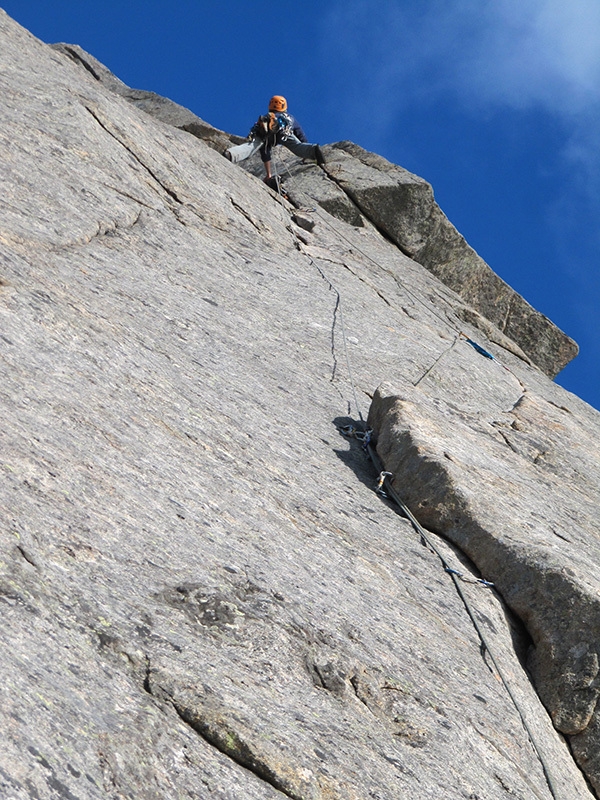
 1 / 12
1 / 12 Giovanni Zaccaria, Alice Lazzaro
Giovanni Zaccaria, Alice Lazzaro
Summer 2012, from 19 August to 4 September. Two young students, with litlle money and other means. A journey from Italy to the distant North. Fueled by the desire fro beauty, to discover something new and climb. Alice Lazzaro and Giovanni Zaccaria, exploring places to them hitherto unknown, experienced something unforgettable, regardless of the grades and impossible undertakings. A real adventure. Or rather, simply "their adventure", in the relentless wind and the marvel of being "scattered" and alone in the great North.
We've been leaving and returning all summer... We return from our mountains and a mere two days are needed to pack our rucksacks for the next fortnight far from home. We tried to glean some useful information off those who had already been there, but our "venture" was original and somewhat unpredictable. 20 kg of climbing gear and other 35 kg of food, clothes and a tent. Just the very basics. We travel slowly northwards… our destination is distant and we begin to yearn. After a flight, two nights spent seated, a 23-hour train journey, a ferry and a bus, exhausted and loaded with gear we pitch our tent between the sea and the rock faces of the Lofoten islands! "A windy place" warns our guidebook... and the seams of our tent notice this all too quick!
The first day wakes us with a light drizzle, weaker though than our desire to go climbing. And so we go for our chosen route: Only blueberries! Saying "only blueberries", in Norway, is like saying "childsplay", and you can easily understand why by simply walking along any old path: picking them is... the opposite of looking for a needle in a haystack! But we aren’t here to learn popular sayings. Bare blåbær (5-) means Only blueberries. Only cracks, only trad gear, only smears, only solid granite. Not blueberries only. Our first approach with Norwegian climbing is by no means a walk in the park, but we begin to become familiar with hand and foot jams, begin to learn to trust the slabby granite despite the humidity. But this experience and the rain take their toll, so night finds us rappelling. As we cook our first Norwegian pasta the sky becomes bright after only a few hours of darkness. Not a bad welcome day to Planet Lofoten!
We need a day to recharge our batteries, dry our shoes, look around and chat with some locals with wrinkled hands. They tell stories of sea and life. Maybe they are one and the same thing. Conflicting weather forecasts accompany the start of Day 3 on Lofoten, even if a glance at the huge amount of food carefully stored in our tent might make you believe we'd only just arrived. We climb Gollum (5) and Guns n’ roses (6-) and consume knuckles and fingertips, making our way up and down the hundred-metre high Gandalf face. We climb all day to the rhythm of the tide behind us, but the snug warmth of our down jackets quickly extinguishes any desire for a quick dip and towel. We're in the mountains after all! The rock is amazing, the climbing never trivial. And on every pitch we learn the hard way what the technical terms in our English guidebook mean. Our tummies make themselves heard, somewhat bothered, reminding us that since breakfast they've only eaten dry fruit and chocolate, but at half past eight in the evening the sun simply doesn't want to set. And so, with a thought for our poor stomach and a knowing glance, we start up the third route of the day: Gandalf (5). Darkness has only just set in when we return to our tent.
"Norway's making fun of us!" we joke as we examine the cloud-covered sky suddenly clear, incredulous and soaked to the bone. We've learnt how to make plans and how to change them continuously, as quickly as the weather changes. And the weather, here on Lofoten, is all-decisive. And so it decides to make us spend an entire day within the four unstable walls of our tent. Alienated and confused, we are at the mercy of the wind and rain that offer no respite.
The following day we discover that, as well as the weather forecast, the bus time-tables are difficult to understand, too, and this forces us change our already flexible plans. Never mind, we opt for two short hard routes close to our base camp, located at an altitude of 0 metres. Lundeklubben, 3 pitches of 5-6, and Skiløperen (6-), a beautiful and sustained slightly overhang single-pitch crack. Thanks to powerful moves rehearsed in the gym (Gio) or hanging like a salami off a belay with two cams (Ali) we conquest these 30m exposed to the wind.
We then return to our tent, strangely with the sun still above the mountain tops and our hands full of blueberries. Our dinner consists of an unusual purple risotto and two fresh fish given to us by Michael, a German fisherman, a lone traveler in the North. Put to the test by this particular dinner experience we decide to delve into our sleeping bags because, weather permitting, a big adventure awaits tomorrow. Vestpillaren (6), the famous, long and hard climb that made it onto the cover of guidebook is now the dream we share. We fall asleep hoping that night will lull our dream and that, when it disappears, it'll give way to some sun.
As fresh as the fish cooked on our stove last night, and as cold as the rock that will soon become one with our hands we walk to the "Priest". From below it looks like a vertical pyramid, awesome and compact. It causes dizziness. The day is beautiful, and it’s all ours. We want to take full advantage of it. The guidebook mentions you can climb the face in 6-8 hours, and that a close-knit team can be even faster. But we're not interested in setting a new record. We slip upwards following perfect cracks, the only holds and protection available. Meanwhile the rucksack sobs and scrapes up the rock, dreaming of being a haulbag. We climb 12 pitches, all of them exceptional, in 12 hours. 12 hours clinging to the face. We are alone, the two of us and the Mountain. We take our time, better still, we take the time we need, our time, the time for the both of us, the time to study the wall and to study each other. The two of us, we're not any old partnership, we're bound by something that goes deeper, and is longer than a rope. When we reach the final pitches the low sun paints the wall yellow. The scene is amazing and becomes impressed in our eyes and transforms into memory.
We'll probably tell our climbing friends about the rain that came at just the wrong moment, about our destroyed hands, the poor protection and the awareness that the only way out was up, but our eyes will shine with the light of that sunset. "There are only trad routes" us climbers from the Dolomites would say… who knows what the Norwegians say about our routes... apart from the fact that "they're all choss!"
All you need to do is go elsewhere and immediately our truths become relative: what we conceive as being good rock, the prevalent climbing ethics... And all of sudden it's no longer normal to find in-situ pegs, or slings at the belays. Trad gear become our only pieces of protection, and we learn to trust them.
Climbing in Norway is different from climbing in Italy… for a short moment we stop comparing, finding complicated names to describe things. We experience what the differences offer and savor them to the utmost. Fullstop. The grades, a plus or a minus, the Norwegian or French grading system, don’t make sense anymore.
We climb and only try to understand where the route will lead us, following our crack to the top with bated breath, to new spectacular views and intense emotions. Despite the guidebook stating that some walls are crowded, during our five days we only encounter two climbers on the Gandalf face. This loneliness, added to the difficulty of finding the right paths that resemble animal tracks more than anything else, make us feel like explorers in a faraway world, even more so due to the unpronounceable names of the mountains. Glancing back means gazing at the deep blue sea, a mirror that induces conflicting feelings. Peace, provided by the vast blue as vast as the yellow granite overhead. And anxiety, that stems from the secrets the sea contains, like the hidden cracks that follow one another who knows where.
We leave Henningsvær nostalgically, we already miss its world suspended between the sea, rocks and clouds. And all of a sudden we reach Svolvær. Our last climb is maybe the most famous on of alle, also perhaps because of the final adrenaline-fueled jump between the two pinnacles: “The Goat” was the first peak the local climbers aimed for, and long ago its ascent was considered impossible. We decide to follow the route forged by the pioneers (1910 ruta (4+)), that were the first to heroically reach the top after ascending the dark north face.
On the top, the jump from one horn to the other is more a mental battle than anything else. As you look at the graveyard down below, see the fear in your partner's face, who doesn’t think the leap possibl, you notice a piece of horn has crumbled…all these things can only provide you with courage! And then… a second later and you're there, on the other horn. In the blink of an eye; all you need is that nudge that only you can give yourself. Nobody else. A moment, followed by a smile.
Our vertical adventure ends here, but our trip continues. Another side of the Lofoten Islands is waiting for us to be explored in different ways. We travel further south to meet special, new and kind people, touch deserted beaches, breath the fjord air from a boat, cycle fast against the rain, and let us be driven by the wind, that here never seems to rest...
We wish you all happy climbing and great adventures!
Alice Lazzaro and Giovanni Zaccaria
We would like to leave some practical tips that would have been useful for us, if perchance someone now likes the idea of making their way up North!
For your Norwegian climbs don’t forget:
Half ropes
Cams and nuts of all sizes
2 pairs of waterproof shoes
Heavy-duty wind and waterproof jacket
Tape for fingers
Low tent (vs wind)
The guidebook: Lofoten Rock, by Chris Craggs and Thorbjørn Enevold



 Copia link
Copia link


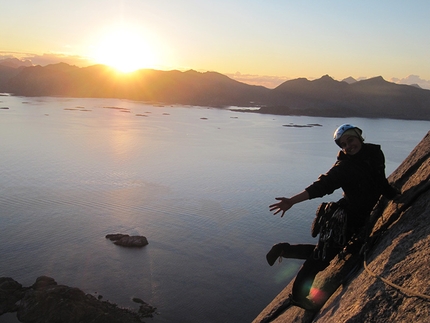
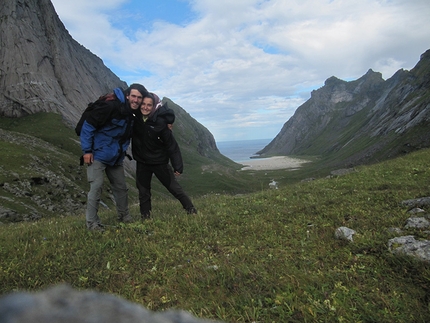
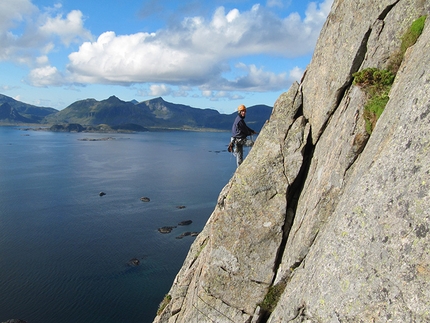
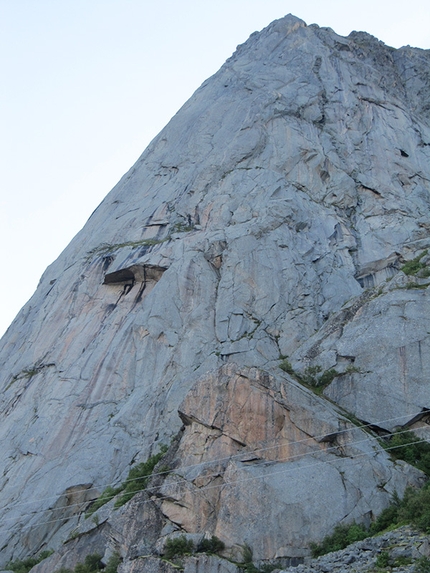
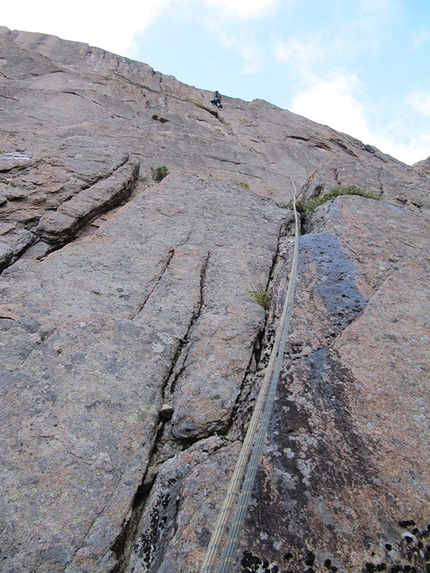
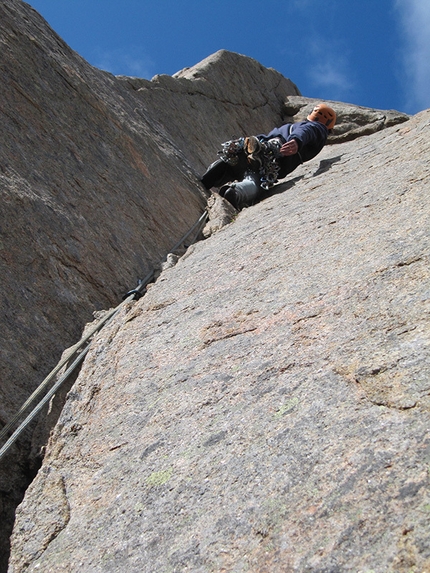
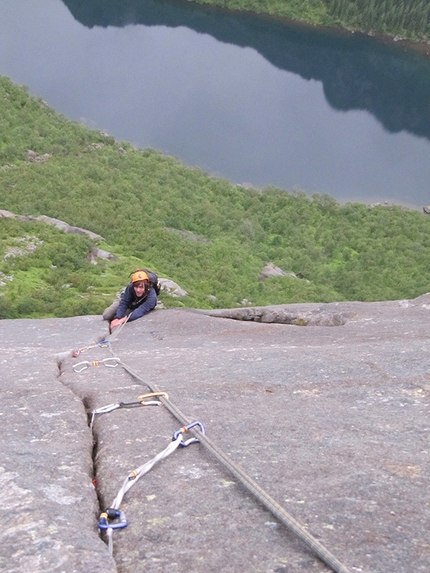
 See all photos
See all photos






















